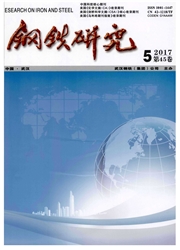

 中文摘要:
中文摘要:
使用指示剂滴定法和"座滴法"研究了烧结熔剂(生石灰、白云石)活性度及高温液相行为。结果表明:生石灰的活性度存在显著差异,生石灰活性度主要取决于"匀速滴定阶段"的活性度;活性度较高的生石灰与Fe_2O_3纯试剂反应的特征温度较低、特征温度区间较窄;石灰石与Fe_2O_3纯试剂反应的特征温度较生石灰低,这主要是由于高温下生成的CaO活性度更高;白云石与Fe_2O_3纯试剂反应的特征温度最高,这主要是由于MgO·Fe_2O_3阻碍了铁酸钙的形成;白云石与Fe_2O_3纯试剂反应后的试样出现了明显的分层现象,内层矿相以MgO形成的高熔点物质为主,外层矿相以低熔点铁酸盐为主。
 英文摘要:
英文摘要:
The activity and high temperature liquid phase behavior of sinter fluxes (lime, dolomite) were studied through the indicator titration method and seat drop method. The results showed that there was a significant difference in the activity of quicklime, which was mainly determined by the activity of "uniform titration stage". The characteristic temperature of high activity quicklime reacting with Fe203 was low and the characteristic temperature range was narrow. The characteristic temperature of limestone reacting with Fe203 was lower than that of quicklime, which was mainly due to the higher CaO activity at high temperature. The characteristic temperature of dolomite reacting with Fe203 was the highest, which was mainly due to MgO. Fe203 blocking the formation of calcium ferrite. Dolomite' reacting with Fe203 formed an obvious stratification. The inner layer was dominated by high melting point substances including MgO, and the outer layer was mainly composed of low melting point ferrite.
 同期刊论文项目
同期刊论文项目
 同项目期刊论文
同项目期刊论文
 期刊信息
期刊信息
